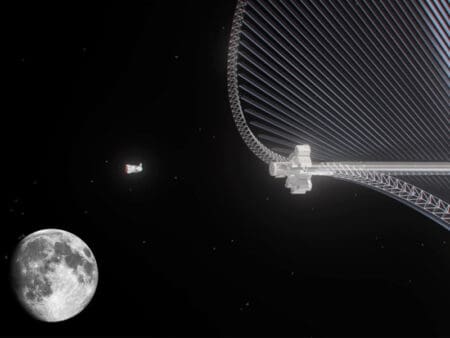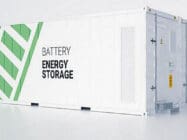
A lunar power satellite modelled, harvesting electricity from the air and solar PV for farmers are on the week’s technology radar.
Lunar power satellite conceived
With the European Space Agency’s Solaris initiative to develop space-based solar power for transmission to Earth just getting underway, the organisation also is starting to investigate the potential for space-based solar to deliver power to the Moon.
With support from ESA’s innovation programme, the Swiss startup Astrostrom has developed a design concept of a ‘Greater Earth Lunar Power Station’ that could be constructed on the Moon mainly from resources there and that could deliver microwave power down to receivers on the lunar surface, for example for powering a base there.
The design features V-shaped Moon-produced iron pyrite crystal-based solar panels with integrated antennas, deployed in a helix configuration extending more than a square kilometre end to end and yielding an estimated continuous 23MW of energy for lunar surface operations.
Have you read?
Predicting space weather to protect the grid
Solar boss worries about depth of renewable energy talent pool
The station, located at a determined point around 61,350 km from the lunar surface, would also be inhabited, serving both as a gateway between Earth and Moon operations with artificial gravity for adaptive health purposes, as well as potentially an attractive tourist destination.
The concept could equally be adapted for the development of Earth facing solar power satellites.
Launching large numbers of gigawatt-scale solar power satellites into orbit from the surface of the Earth could run into the problem of a lack of launch capacity and a lunar-made solar power satellite would require around five times less velocity change to place into geostationary Earth orbit compared to satellites launched from Earth itself.
According to the study the power station could be achieved without requiring any technological breakthroughs, with most of the core technologies for lunar surface mining, beneficiation and fabrication operations already in use or under development on Earth today.
Moreover – and despite the substantial engineering development required – the solar power satellites produced on the Moon would not only be cheaper than any comparable Earth-developed solar power satellite, but the electricity they generated for Earth would also be cost-competitive with any terrestrial power alternative.
Harvesting electricity from air
If new research from the University of Massachusetts Amherst is anything to go by, almost any material could be turned into a device that continuously harvests electricity from humidity in the air.
The secret, according to the researchers, lies in being able to pepper the material with nanopores, or small holes, less than 100nm in diameter – less than a thousandth of the width of a human hair.
This number corresponds to the ‘mean free path’ of water molecules when suspended in air. An energy harvester made from a thin layer of material filled with nanopores smaller than 100nm would let water molecules pass from the upper to the lower part of the material, but as the pores are so small, the water molecules would easily bump into the pore’s edge as they pass through the thin layer.
This means that the upper part of the layer would be bombarded with many more charge-carrying water molecules than the lower part, creating a charge imbalance, thereby effectually create a battery and one that runs as long as there is any humidity in the air.
“Think of a cloud, which is nothing more than a mass of water,” says Jun Yao, assistant professor of electrical and computer engineering in the College of Engineering at UMass Amherst, and the work’s senior author.
“Each of those droplets contains a charge, and when conditions are right, the cloud can produce a lightning bolt – but we don’t know how to reliably capture electricity from lightning. What we’ve done is to create a human-built, small-scale cloud that produces electricity for us predictably and continuously so that we can harvest it.”
Since humidity is ever present, a harvester should be able to run 24/7, rain or shine, day or night and whether or not the wind blows.
Moreover, as the thickness is so tiny, many thousands could be stacked to create a device capable of delivering kilowatt-level power.
Solar PV for agriculture
With the need to install renewables in different locations, French solar energy developer TSE has come up with the concept of PV canopies for installation in agricultural settings.
In 2022, the company installed its first agrovoltaics pilot site of 3ha in north central France, comprised of a PV shading system with a capacity of 2.4MWp – equivalent to the power consumption of a community of 1,350 inhabitants – over large-scale crops of soya, wheat, forage rye, winter barley and rapeseed.
The project came into being because of production limitations on the farm after suffering from hot and arid summers for more than a decade.
The agricultural canopy is composed of a large shading structure equipped with solar panels with tracker systems fixed on cables 5m above the fields. A supervision system controls the orientation of the panels, depending on the weather conditions and to completely automate the acquisition of operational data.
With the rotating shades, the system is able to mitigate climatic conditions in the summer season by lowering the temperature under the shade.
The pilot is a 9-year demonstrator and three similar projects are reported under construction along with a further 12 in the development phase.








